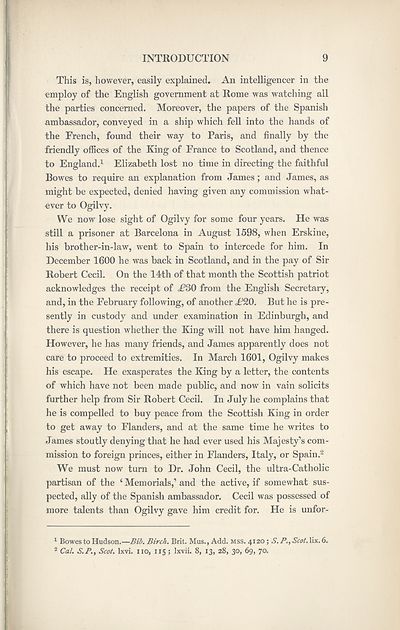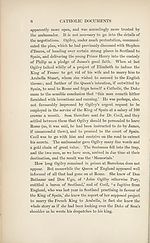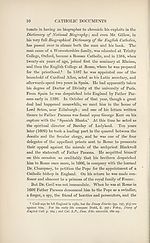Download files
Complete book:
Individual page:
Thumbnail gallery: Grid view | List view

INTRODUCTION
9
This is, however, easily explained. An intelligencer in the
employ of the English government at Rome was watching all
the parties concerned. Moreover, the papers of the Spanish
ambassador, conveyed in a ship which fell into the hands of
the French, found their way to Paris, and finally by the
friendly offices of the King of France to Scotland, and thence
to England.1 Elizabeth lost no time in directing the faithful
Bowes to require an explanation from James; and James, as
might be expected, denied having given any commission what¬
ever to Ogilvy.
We now lose sight of Ogilvy for some four years. He was
still a prisoner at Barcelona in August 1598, when Erskine,
his brother-in-law, went to Spain to intercede for him. In
December 1600 he was back in Scotland, and in the pay of Sir
Robert Cecil. On the 14th of that month the Scottish patriot
acknowledges the receipt of J?30 from the English Secretary,
and, in the February following, of another JP20. But he is pre¬
sently in custody and under examination in Edinburgh, and
there is question whether the King will not have him hanged.
However, he has many friends, and James apparently does not
care to proceed to extremities. In March 1601, Ogilvy makes
his escape. He exasperates the King by a letter, the contents
of which have not been made public, and now in vain solicits
further help from Sir Robert Cecil. In July he complains that
he is compelled to buy peace from the Scottish King in order
to get away to Flanders, and at the same time he writes to
James stoutly denying that he had ever used his Majesty’s com¬
mission to foreign princes, either in Flanders, Italy, or Spain.2
We must now turn to Dr. John Cecil, the ultra-Catholic
partisan of the ‘ Memorials,’ and the active, if somewhat sus¬
pected, ally of the Spanish ambassador. Cecil was possessed of
more talents than Ogilvy gave him credit for. He is unfor-
1 Bowes to Hudson.—Bib. Birch. Brit. Mus., Add. mss. 4120 ; S. P., Scot. lix. 6.
2 Cal. S.P., Scot. Ixvi. no, 115; Ixvii. 8, 13, 28, 30, 69, 70.
9
This is, however, easily explained. An intelligencer in the
employ of the English government at Rome was watching all
the parties concerned. Moreover, the papers of the Spanish
ambassador, conveyed in a ship which fell into the hands of
the French, found their way to Paris, and finally by the
friendly offices of the King of France to Scotland, and thence
to England.1 Elizabeth lost no time in directing the faithful
Bowes to require an explanation from James; and James, as
might be expected, denied having given any commission what¬
ever to Ogilvy.
We now lose sight of Ogilvy for some four years. He was
still a prisoner at Barcelona in August 1598, when Erskine,
his brother-in-law, went to Spain to intercede for him. In
December 1600 he was back in Scotland, and in the pay of Sir
Robert Cecil. On the 14th of that month the Scottish patriot
acknowledges the receipt of J?30 from the English Secretary,
and, in the February following, of another JP20. But he is pre¬
sently in custody and under examination in Edinburgh, and
there is question whether the King will not have him hanged.
However, he has many friends, and James apparently does not
care to proceed to extremities. In March 1601, Ogilvy makes
his escape. He exasperates the King by a letter, the contents
of which have not been made public, and now in vain solicits
further help from Sir Robert Cecil. In July he complains that
he is compelled to buy peace from the Scottish King in order
to get away to Flanders, and at the same time he writes to
James stoutly denying that he had ever used his Majesty’s com¬
mission to foreign princes, either in Flanders, Italy, or Spain.2
We must now turn to Dr. John Cecil, the ultra-Catholic
partisan of the ‘ Memorials,’ and the active, if somewhat sus¬
pected, ally of the Spanish ambassador. Cecil was possessed of
more talents than Ogilvy gave him credit for. He is unfor-
1 Bowes to Hudson.—Bib. Birch. Brit. Mus., Add. mss. 4120 ; S. P., Scot. lix. 6.
2 Cal. S.P., Scot. Ixvi. no, 115; Ixvii. 8, 13, 28, 30, 69, 70.
Set display mode to:
![]() Universal Viewer |
Universal Viewer | ![]() Mirador |
Large image | Transcription
Mirador |
Large image | Transcription
Images and transcriptions on this page, including medium image downloads, may be used under the Creative Commons Attribution 4.0 International Licence unless otherwise stated. ![]()
| Scottish History Society volumes > Series 1 > Miscellany of the Scottish History Society (First volume) > (102) Page 9 |
|---|
| Permanent URL | https://digital.nls.uk/127082085 |
|---|
| Attribution and copyright: |
|
|---|
| Description | Over 180 volumes, published by the Scottish History Society, containing original sources on Scotland's history and people. With a wide range of subjects, the books collectively cover all periods from the 12th to 20th centuries, and reflect changing trends in Scottish history. Sources are accompanied by scholarly interpretation, references and bibliographies. Volumes are usually published annually, and more digitised volumes will be added as they become available. |
|---|


